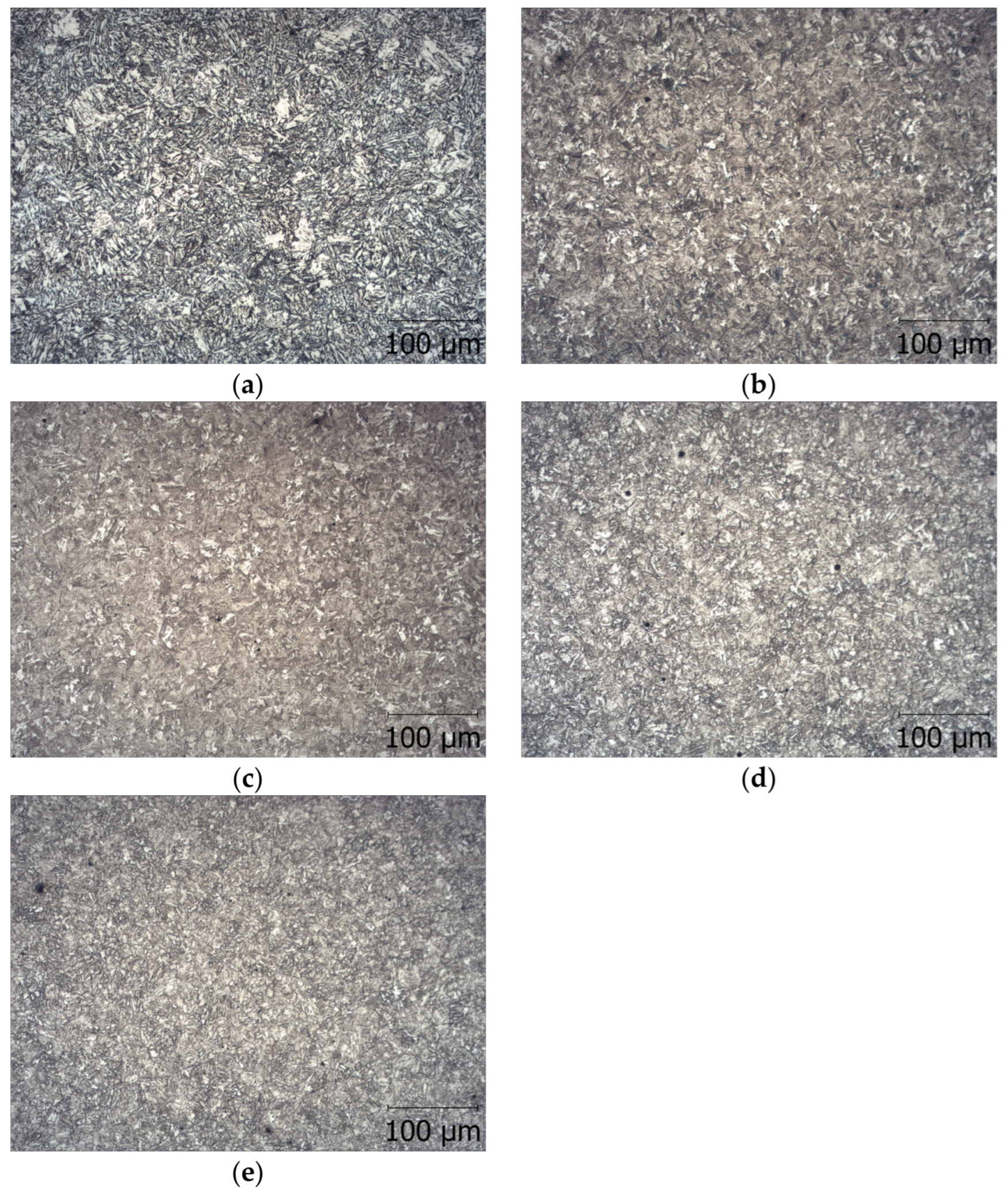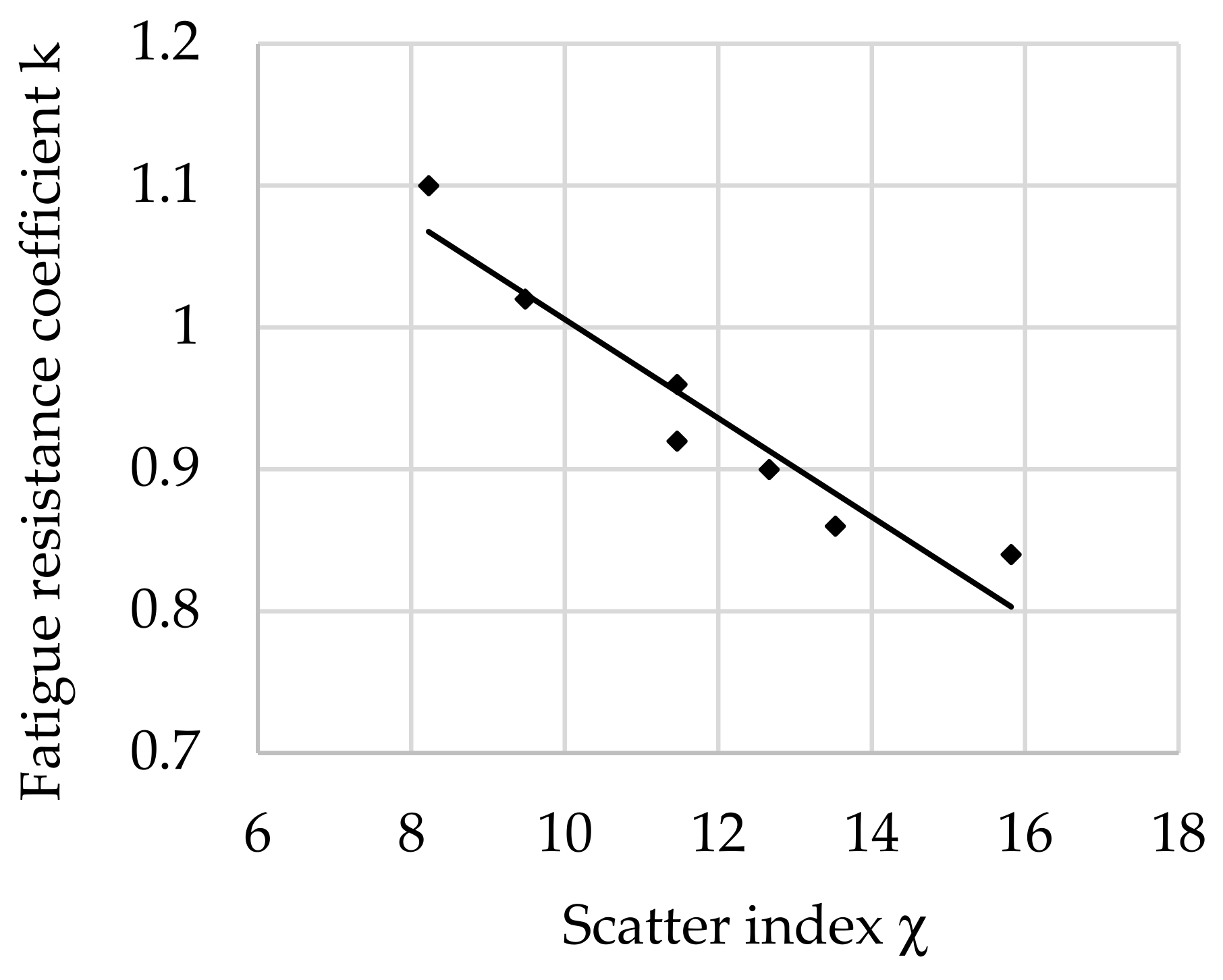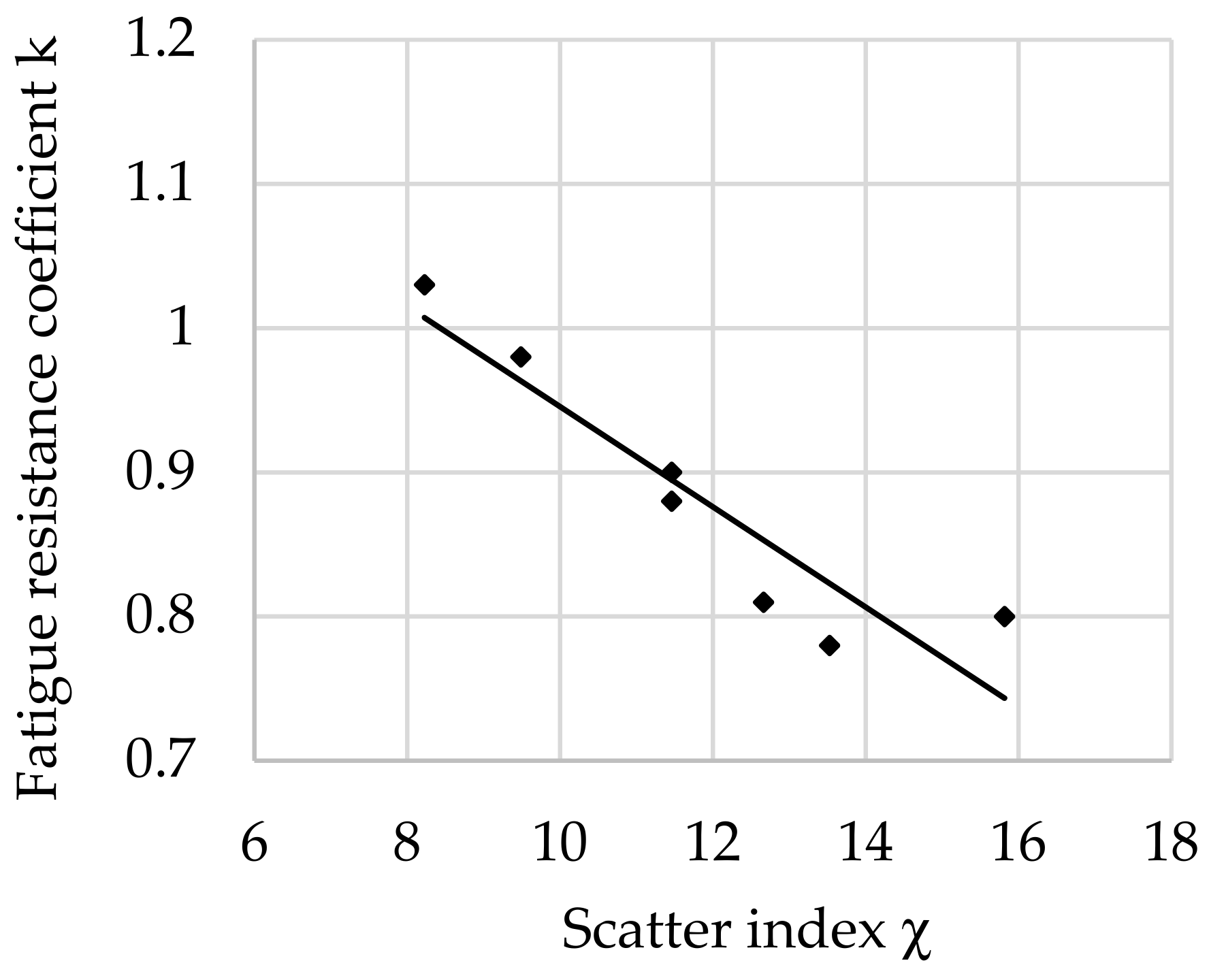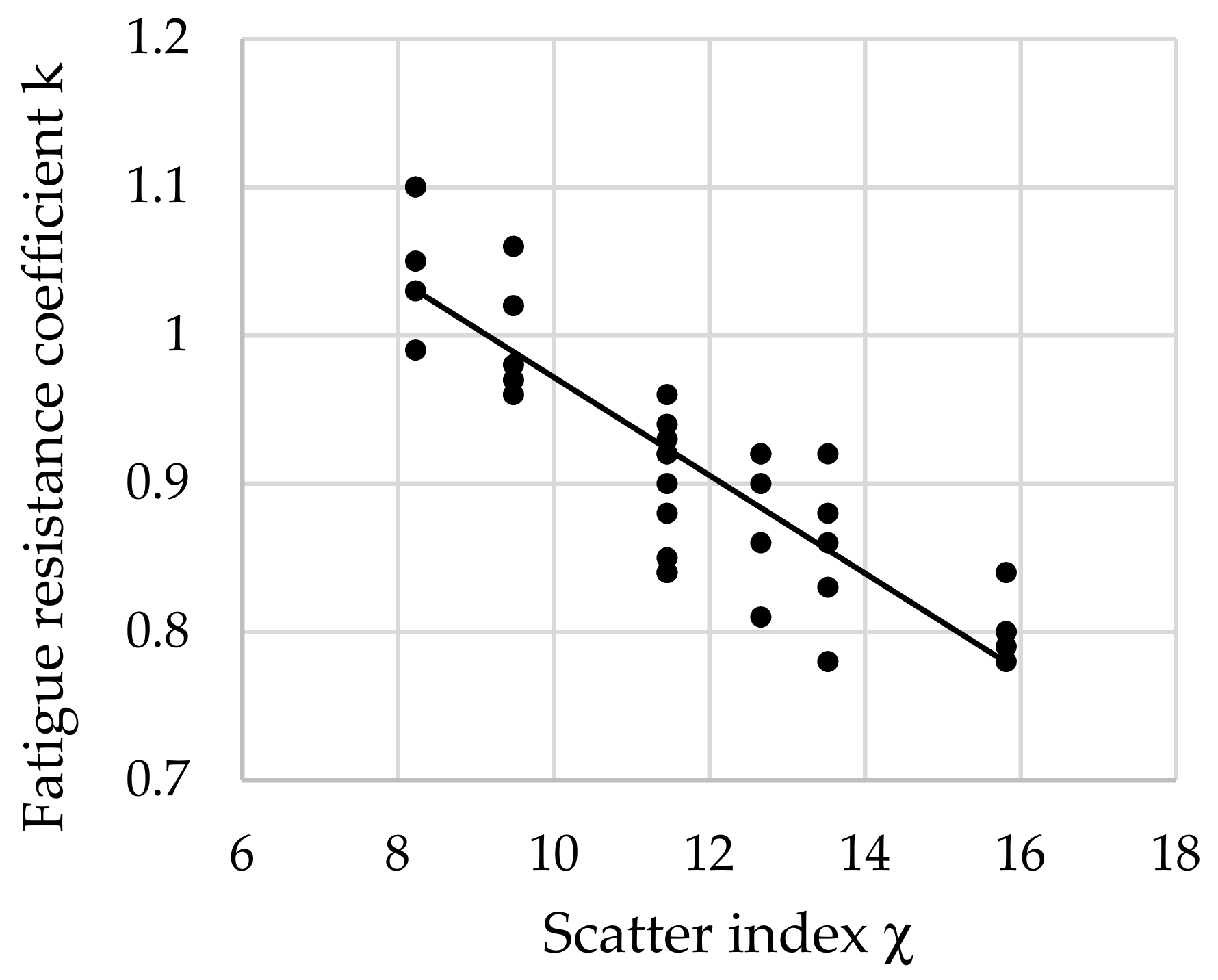Influence of the Scatter Index of Non-Metallic Inclusions in Structural Steel on the Fatigue Resistance Coefficient
Abstract
1. Introduction
- zg—fatigue strength, MPa;
- c—the proportionality coefficient of fatigue strength and tensile strength;
- d—the proportionality coefficient of tensile strength and hardness;
- Rm—tensile strength, MPa;
- H—hardness, MPa;
- k—fatigue resistance coefficient.
2. Materials and Methods
- —average diameter of impurities, µm;
- V—relative volume of impurities, %.
- k(tempering temp.)—fatigue resistance coefficient for the assumed tempering temperature;
- a and b—coefficients of the equation;
- χ—scatter index.
- s—standard deviation;
- r—correlation coefficient.
3. Results
4. Discussion
5. Conclusions
Funding
Institutional Review Board Statement
Informed Consent Statement
Data Availability Statement
Conflicts of Interest
References
- Kasatkin, G.N. Effect of nonmetallic inclusions on the mechanical properties of hydrogenated steels. Mater. Sci. 2004, 40, 850–855. [Google Scholar] [CrossRef]
- Roiko, A.; Hänninen, H.; Vuorikari, H. Anisotropic distribution of non-metallic inclusions in forged steel roll and its influence on fatigue limit. Int. J. Fatigue 2012, 41, 158–167. [Google Scholar] [CrossRef]
- Zhao, Y.; Li, T.; Tang, G.; Gup, H.; Yan, J.; Gou, X.; Zhu, Y. Characterization of the morphological evolution of MnS inclusions in free-cutting steel during heating. J. Mater. Res. Technol. 2022, 17, 1427–1437. [Google Scholar] [CrossRef]
- Lipiński, T.; Wach, A.; Detyna, E. Influence of large non-metallic inclusions on bending fatigue strength hardened and tempered steels. Adv. Mater. Sci. 2015, 15, 33–40. [Google Scholar] [CrossRef]
- Hua, L.; Deng, S.; Han, X.; Huang, S. Effect of material defects on crack initiation under rolling contact fatigue in a bearing ring. Tribol. Int. 2013, 66, 315–323. [Google Scholar] [CrossRef]
- Yang, M.; Gao, C.; Pang, J.; Li, S.; Hu, D.; Li, X.; Zhang, Z. High-Cycle Fatigue Behavior and Fatigue Strength Prediction of Differently Heat-Treated 35CrMo Steels. Metals 2022, 12, 688. [Google Scholar] [CrossRef]
- Lipiński, T.; Ulewicz, R. The effect of the impurities spaces on the quality of structural steel working at variable loads. Open Eng. 2021, 11, 233–238. [Google Scholar] [CrossRef]
- Suresh, S. Fatigue of Materials; Cambridge University Press: Cambridge, UK, 1998. [Google Scholar]
- Milovanovi’c, V.; Duni’c, V.; Raki´c, D.; Živkovi’c, M. Identification causes of cracking on the underframe of wagon for containers transportation—Fatigue strength assessment of wagon welded joints. Eng. Fail. Anal. 2013, 31, 118–131. [Google Scholar] [CrossRef]
- Chan, K.S. Roles of microstructure in fatigue crack initiation. Int. J. Fatigue 2010, 32, 1428–1447. [Google Scholar] [CrossRef]
- Zhang, L.; Pluschkell, W. Nucleation and growth kinetics of inclusions during liquid steel deoxidation. Ironmak. Steelmak. 2003, 30, 106–110. [Google Scholar] [CrossRef]
- Gu, C.; Liu, W.Q.; Lian, J.H.; Bao, Y.P. In-depth analysis of the fatigue mechanism induced by inclusions for high-strength bearing steels. Int. J. Miner. Metall. Mater. 2021, 28, 826–834. [Google Scholar]
- Lipiński, T. Influence of non-metallic inclusions on bending fatigue strength of high-quality carbon constructional steel heated in an industrial electric arc furnace. Materials 2022, 15, 6140. [Google Scholar] [CrossRef]
- Zhou, D.G.; Fu, J.; Chen, X.C.; Li, J. Study on oxygen content, inclusions and fatigue properties of bearing steels produced by different processes. J. Univ. Sci. Technol. Beijing 2001, 8, 25–27. [Google Scholar]
- Podorska, D.; Drożdż, P.; Falkus, J.; Wypartowicz, J. Calculations of oxide inclusions composition in the steel deoxidized with Mn, Si and Ti. Arch. Metall. Mater. 2006, 51, 581–586. [Google Scholar]
- Gulyakov, V.S.; Vusikhis, A.S.; Kudinov, D.Z. Nonmetallic oxide inclusions and oxygen in the vacuum_jet refining of steel. Steel Transl. 2012, 42, 781–783. [Google Scholar] [CrossRef]
- Guo, Y.; Chen, F.; Liu, B.; Yu, H.; Deng, H. Effect of stress ratio and evaluation of crack sizes on very-high-cycle-fatigue crack propagation life prediction of carburized Cr-Ni steel. Metals 2022, 12, 1485. [Google Scholar] [CrossRef]
- Kováčiková, P.; Dubec, A.; Kuricová, J. The microstructural study of a damaged motorcycle gear wheel. Manuf. Technol. 2021, 21, 83–90. [Google Scholar] [CrossRef]
- Lipiński, T.; Wach, A. The effect of fine non-metallic inclusions on the fatigue strength of structural steel terms and conditions. Arch. Metall. Mater. 2015, 60, 65–69. [Google Scholar] [CrossRef]
- Spriestersbach, D.; Grad, P.; Kerscher, E. Influence of different non-metallic inclusion types on the crack initiation in high-strength steels in the VHCF regime. Int. J. Fatigue 2014, 64, 114–120. [Google Scholar] [CrossRef]
- Lipiński, T.; Wach, A. Influence of outside furnace treatment on purity medium carbon steel. In Proceedings of the METAL 2014—23rd International Conference on Metallurgy and Materials, Brno, Czech Republic, 21–23 May 2014; pp. 738–743. [Google Scholar]
- Lipa, S.; Sawicki, J.; Dybowski, K.; Pietrasik, R.; Januszewicz, B. The effect of non-metallic inclusions formed as a result of deoxidation on the fatigue strength of 15CrNi6 and 16MnCr5 steel. Arch. Metall. Mater. 2018, 63, 1345–1350. [Google Scholar]
- Costa e Silva, A. Non-metallic inclusions in steels—Origin and control. J. Mater. Res. Technol. 2018, 7, 283–299. [Google Scholar] [CrossRef]
- Shi, Z.Y.; Li, J.J.; Zhang, X.D.; Shang, C.J.; Cao, W.Q. Influence mechanisms of inclusion types on rotating bending fatigue properties of SAE52100 bearing steel. Materials 2022, 15, 5037. [Google Scholar] [CrossRef] [PubMed]
- Dong, Z.; Qian, D.; Yin, F.; Wang, F. Enhanced impact toughness of previously cold rolled high-carbon chromium bearing steel with rare earth addition. J. Mater. Eng. Perform. 2021, 30, 8178–8187. [Google Scholar] [CrossRef]
- Melander, A.; Rolfsson, M.; Nordgren, A.; Jansson, B.; Hedberg, H.; Lund, T. Influence of inclusion contents on fatigue properties of SAE-52100 bearing steels. Scand. J. Metall. 1991, 20, 229–244. [Google Scholar]
- Lipiński, T. Morphology of impurities in steel after desulfurization and vacuum degassing. In Proceedings of the 14th International Scientific Conference Engineering for Rural Development, Jelgava, Latvia, 20–22 May 2015; pp. 795–800. [Google Scholar]
- Halford, G.L. Low Cycle Thermal Fatigue; NASA: Washington, DC, USA, 1986.
- Lipiński, T.; Pietraszek, J.; Wach, A. Influence of oxygen content in medium carbon steel on bending fatigue strength. In Proceedings of the 21st International Scientific Conference Engineering for Rural Development Proceedings, Jelgava, Latvia, 25–27 May 2022; Volume 21, pp. 351–356. [Google Scholar]
- Ulewicz, R.; Szataniak, P.; Novy, F.; Trsko, L.; Bokuvka, O. Fatigue characteristics of structural steels in the gigacycle region of loading. Mater. Today Proc. 2017, 4, 5979–5984. [Google Scholar] [CrossRef]
- Lipinski, T.; Wach, A. Effect of impurities on bending fatigue strength of structural steel. In Proceedings of the 14th International Scientific Conference Engineering for Rural Development, Jelgava, Latvia, 20–22 May 2015; pp. 784–789. [Google Scholar]
- Scorza, D.; Carpinteri, A.; Ronchei, C.; Vantadori, S.; Zanichelli, A. A novel methodology for fatigue assessment of high strength steels with non-metallic inclusions. Procedia Struct. Integr. 2022, 39, 503–508. [Google Scholar] [CrossRef]
- Zhang, G.; Zhang, Q.; Yang, J.; Xie, Z.; Zhang, L.; Liu, R.; Li, G.; Wang, H.; Fang, Q.; Wang, X. Microstructures and tensile properties of 9Cr-f/m steel at elevated temperatures. Materials 2022, 15, 1248. [Google Scholar] [CrossRef]
- Macek, W.; Szala, M.; Trembacz, J.; Branco, R.; Costa, J. Effect of non-zero mean stress bending-torsion fatigue on fracture surface parameters of 34CrNiMo6 steel notched bars. Prod. Eng. Arch. 2020, 26, 167–173. [Google Scholar] [CrossRef]
- Murakami, Y.; Kodama, S.; Konuma, S. Quantitative evaluation of effects of non-metallic inclusions on fatigue strength of high strength steels, I: Basic fatigue mechanism and fatigue fracture stress and the size and location of non-metallic inclusions. Int. J. Fatigue 1989, 11, 291–298. [Google Scholar] [CrossRef]
- Duc, M.L.; Thu, M.T. Application of Lean Six Sigma for Improve Productivity at The Mechanical Plant. A Case Study. Manuf. Technol. 2022, 22, 124–138. [Google Scholar]
- Ossola, E.; Pagliassotto, S.; Rizzo, S.; Sesana, R. Microinclusion and fatigue performance of bearing rolling elements. In Mechanical Fatigue of Metals: Experimental and Simulation Perspectives; Springer: Berlin/Heidelberg, Germany, 2019; Volume 7, pp. 321–326. [Google Scholar]
- Jonšta, P.; Jonšta, Z.; Brožová, S.; Ingaldi, M.; Pietraszek, J.; Klimecka-Tatar, D. The effect of rare earth metals alloying on the internal quality of industrially produced heavy steel forgings. Materials 2021, 14, 5160. [Google Scholar] [CrossRef]
- Zhang, L.; Ren, Q.; Duan, H.; Ren, Y.; Chen, W.; Cheng, G.; Yang, W.; Sridhar, S. Modelling of non-metallic inclusions in steel. Miner. Process. Extr. Metall. 2020, 129, 184–206. [Google Scholar] [CrossRef]
- Cuartas, M.; Ruiz, E.; Ferreño, D.; Setién, J.; Arroyo, V.; Gutiérrez-Solana, F. Machine learning algorithms for the prediction of non-metallic inclusions in steel wires for tire reinforcement. J. Intell. Manuf. 2021, 32, 1739–1751. [Google Scholar] [CrossRef]
- Kocańda, S. Fatigue Failure of Metals; WNT: Warsaw, Poland, 1985. (In Polish) [Google Scholar]
- Yanase, K.; Endo, M. Multiaxial high cycle fatigue threshold with small defects and craks. Eng. Mech. 2014, 123, 182–196. [Google Scholar]
- Srivastava, A.; Ponson, L.; Osovski, S.; Bouchaud, E.; Tvergaard, V.; Needleman, A. Effect of inclusion density on ductile fracture toughness and roughness. J. Mech. Phys. Solids 2014, 63, 62–79. [Google Scholar] [CrossRef]
- Lipiński, T.; Wach, A. Dimensional structure of non-metallic inclusions in high-grade medium carbon steel melted in an electric furnace and subjected to desulfurization. Solid State Phenom. 2015, 223, 46–53. [Google Scholar] [CrossRef]
- Yang, Z.G.; Zhang, J.M.; Li, S.X.; Li, G.Y.; Wang, Q.Y.; Hui, W.J.; Weng, Y.Q. On the critical inclusion size of high strength steels under ultra-high cycle fatigue. Mater. Sci. Eng. A 2006, 427, 167–174. [Google Scholar] [CrossRef]
- Qayyum, F.; Umar, M.; Elagin, V.; Kirschner, M.; Hoffmann, F.; Guk, S.; Prahl, U. Influence of non-metallic inclusions on local deformation and damage behavior of modified 16MnCrS5 steel. Crystals 2022, 12, 281. [Google Scholar] [CrossRef]
- Lipiński, T.; Wach, A. The Effect of the Production Process and Heat Processing Parameters on the Fatigue Strength of High-Grade Medium-Carbon Steel. Arch. Foundry Eng. 2012, 12, 55–60. [Google Scholar] [CrossRef]
- Wang, Y.H.; Yang, Z.N.; Zhang, F.C.; Qin, Y.M.; Wang, X.B.; Lv, B. Microstructures and properties of a novel carburizing nano-bainitic bearing steel. Mat. Sci. Eng. Struct. 2020, 777, 139086. [Google Scholar] [CrossRef]
- Wang, K.; Jiang, M.; Wang, X.; Wan, W.; Wang, Y. Behavior of Dual-Phase (MnO-SiO2-Al2O3) + (SiO2) Inclusions in Saw Wire Steels During Hot Rolling and Cold Drawing. Metall. Mater. Trans. B 2020, 51, 95–101. [Google Scholar] [CrossRef]
- He, X.; Wang, M.; Hu, C.; Xu, L. Study of the relationship among total oxygen, inclusions and fatigue properties of gear steel. Mater. Sci. Eng. A 2021, 827, 14199. [Google Scholar] [CrossRef]
- Wang, Z.; Xing, Z.; Wang, H.; Shan, D.; Huang, Y.; Xu, Z.; Xie, F. The relationship between inclusions characteristic parameters and bending fatigue performance of 20Cr2Ni4A gear steel. Int. J. Fatigue 2022, 155, 106594. [Google Scholar] [CrossRef]
- Lipiński, T. Effect of Non-Metallic Inclusions on the Fatigue Strength Coefficient of High-Purity Constructional Steel Heated in Industrial Conditions. Appl. Sci. 2022, 12, 9292. [Google Scholar] [CrossRef]
- Ling, H.; Zhang, L.; Li, H. Mathematical modeling on the growth and removal of non-metallic inclusions in the molten steel in a two-strand continuous casting tundish. Metall. Mater. Trans. B 2016, 47, 2991–3012. [Google Scholar] [CrossRef]
- Gu, C.; Lian, J.; Bao, Y.; Münstermann, S. Microstructure-based fatigue modelling with residual stresses: Prediction of the microcrack initiation around inclusions. Mater. Sci. Eng. A 2019, 751, 133–141. [Google Scholar] [CrossRef]
- Anderson, C.W.; Shi, G.; Atkinson, H.V.; Sellars, C.M. The precision of methods using the statistics of extremes for the estimation of the maximum size of inclusions in clean steels. Acta Mater. 2000, 48, 4235–4246. [Google Scholar] [CrossRef]
- PN-74/H-04327; Metals Testing for Fatigue. Axial Tensile-Compression Test at a Constant Cycle of External Loads. PKN Polski Komitet Normalizacyjny: Warsaw, Poland, 1974.
- Yaguchi, H. Engineering Steels. Encycl. Mater. Met. Alloy. 2022, 2, 153–161. [Google Scholar]
- Park, J.H.; Kim, D.; Min, D.J. Characterization of Nonmetallic Inclusions in High-Manganese and Aluminum-Alloyed Austenitic Steels. Metall. Mater. Trans. A 2012, 43, 2316–2324. [Google Scholar] [CrossRef]









| Chemical Element | C wt. % | Mn wt. % | P wt. % | S wt. % | Cr wt. % | Mo wt. % | Ni wt. % | Si wt. % | Cu wt. % | B wt. % |
|---|---|---|---|---|---|---|---|---|---|---|
| Average contents | 0.259 | 1.183 | 0.020 | 0.011 | 0.524 | 0.246 | 0.500 | 0.236 | 0.154 | 0.0027 |
| Standard deviation | 0.030 | 0.190 | 0.003 | 0.003 | 0.030 | 0.016 | 0.040 | 0.069 | 0.040 | 0.0008 |
| Tempering Temperature | °C | 200 | 300, 400, 500 | 600 |
|---|---|---|---|---|
| Applied load | MPa | 650 | 600 | 540 |
| Tempering Temperature | °C | 200 | 300 | 400 | 500 | 600 |
|---|---|---|---|---|---|---|
| Vickers hardness | HV | 432 | 412 | 372 | 333 | 275 |
| Standard deviation | HV | 21 | 17 | 29 | 23 | 30 |
| Tempering Temperature °C | Dissipation Fatigue Resistance Coefficient k (6) | Correlation Coefficient r | Test Probability tα = 0.05 | Critical Value from Student’s Distribution for tα = 0.05 and p = (n − 1) |
|---|---|---|---|---|
| 200 | 0.0540 | 0.956 | 7.9822 | |
| 300 | 0.0728 | 0.9237 | 5.9058 | |
| 400 | 0.1048 | 0.8819 | 4.5822 | 2.4469 |
| 500 | 0.0438 | 0.9564 | 8.0213 | |
| 600 | 0.0996 | 0.8232 | 3.5516 | |
| all | 0.0887 | 0.8703 | 10.3035 | 2.0452 |
Disclaimer/Publisher’s Note: The statements, opinions and data contained in all publications are solely those of the individual author(s) and contributor(s) and not of MDPI and/or the editor(s). MDPI and/or the editor(s) disclaim responsibility for any injury to people or property resulting from any ideas, methods, instructions or products referred to in the content. |
© 2023 by the author. Licensee MDPI, Basel, Switzerland. This article is an open access article distributed under the terms and conditions of the Creative Commons Attribution (CC BY) license (https://creativecommons.org/licenses/by/4.0/).
Share and Cite
Lipiński, T. Influence of the Scatter Index of Non-Metallic Inclusions in Structural Steel on the Fatigue Resistance Coefficient. Materials 2023, 16, 2758. https://doi.org/10.3390/ma16072758
Lipiński T. Influence of the Scatter Index of Non-Metallic Inclusions in Structural Steel on the Fatigue Resistance Coefficient. Materials. 2023; 16(7):2758. https://doi.org/10.3390/ma16072758
Chicago/Turabian StyleLipiński, Tomasz. 2023. "Influence of the Scatter Index of Non-Metallic Inclusions in Structural Steel on the Fatigue Resistance Coefficient" Materials 16, no. 7: 2758. https://doi.org/10.3390/ma16072758
APA StyleLipiński, T. (2023). Influence of the Scatter Index of Non-Metallic Inclusions in Structural Steel on the Fatigue Resistance Coefficient. Materials, 16(7), 2758. https://doi.org/10.3390/ma16072758






